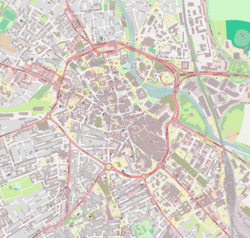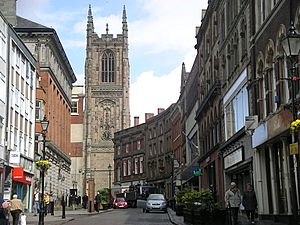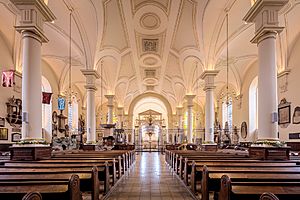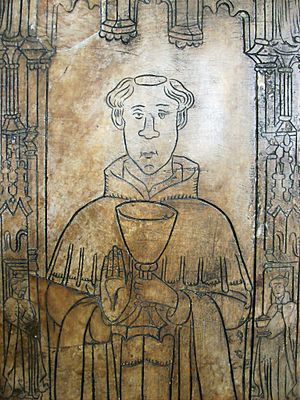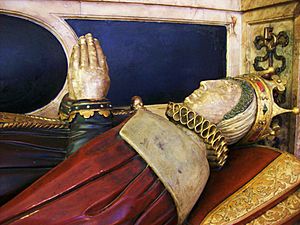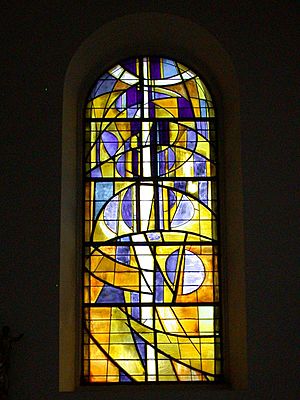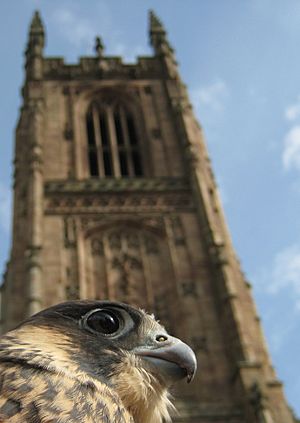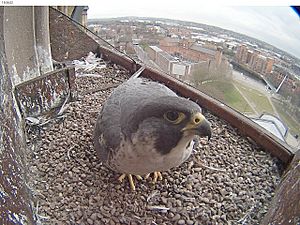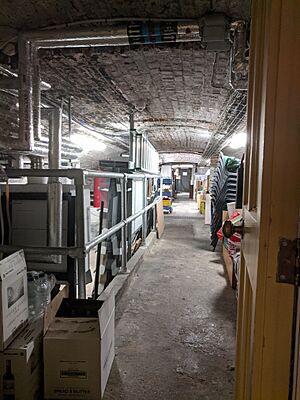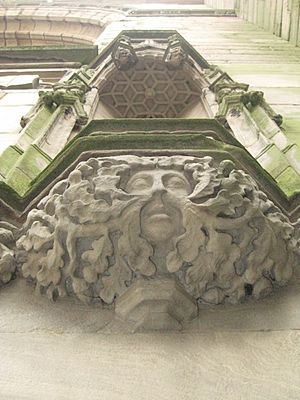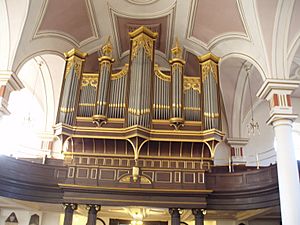Derby Cathedral facts for kids
Quick facts for kids Derby Cathedral |
|
|---|---|
| Cathedral Church of All Saints | |
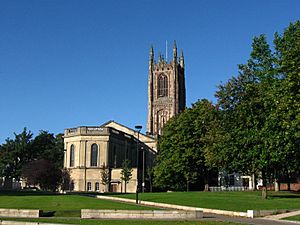
East view of the cathedral
|
|
| 52°55′29″N 1°28′38″W / 52.9248°N 1.4773°W | |
| Location | Derby, Derbyshire |
| Country | England |
| Denomination | Church of England |
| Previous denomination | Roman Catholic |
| History | |
| Former name(s) | All Saints' Church, Derby (6th century – 1927) |
| Consecrated | 1927 |
| Architecture | |
| Style | Gothic, Neoclassical |
| Years built | c. 1530–1725 renovated 1969–1975, 2015–2016 |
| Specifications | |
| Number of towers | 1 |
| Tower height | 212 feet (65 m) |
| Administration | |
| Diocese | Derby (since 1927) |
| Province | Canterbury |
The Cathedral Church of All Saints, Derby, usually called Derby Cathedral, is a large church in the city of Derby, England. In 1927, it became a cathedral, which means it became the main church for the Bishop of Derby.
The first church on this spot, called All Saints, was built around the mid-10th century. The main part of the church you see today was rebuilt in the 1700s by an architect named James Gibbs. The tall tower is much older, from the 1500s, and a newer section was added in the 1900s.
Contents
History of Derby Cathedral
Early Church Buildings
The first church, dedicated to All Saints, was likely built around 943 by King Edmund I. No parts of this original building remain today. After the Norman Conquest in 1066, the church belonged to the king and was served by seven priests.
The old Saxon church probably became unsafe and was taken down. A new church was built in the 1300s, which was about the same size as the building we see now. From 1510 to 1532, the impressive 212-foot (65 m) tower was built. This tower is in the Perpendicular Gothic style. You can see twelve large carved animal figures on top of the tower, and stone faces of a Green Man near the main West Door. The tower was built using sandstone from a nearby quarry.
In 1556, during the time of Queen Mary I, a woman named Joan Waste was tried for her beliefs inside the Church of All Saints.
Rebuilding the Church
By the mid-1600s, the church building was in very poor condition. In 1723, the vicar, Dr. Michael Hutchinson, decided the church needed to be rebuilt. He had the old church taken down overnight. The people of Derby then started raising money to build a new church. Dr. Hutchinson worked hard to collect funds and even gave a lot of his own money.
The original tower from the 1530s was kept, but the rest of the church was rebuilt in a new style called Neo-Classical. This design was created in 1725 by architect James Gibbs. He wanted the inside of the church to be simple and open. To make it more interesting, Gibbs added a beautiful wrought iron screen across the front of the church. This screen was made by a local metalworker named Robert Bakewell. The new church opened in November 1725.
On July 1, 1927, All Saints' Church officially became a cathedral. Later, between 1967 and 1972, a new section called a retroquire was added to the east end of the building.
Inside the Cathedral
The cathedral has many interesting features. One of its most famous treasures is the 18th-century wrought iron screen made by Robert Bakewell. You can also see a monument with a statue of Bess of Hardwick, a very famous woman from history. There are also brass memorials to her family, the Cavendish family.
The entrance gates to the cathedral were also made by Robert Bakewell. They were moved here in 1957 and were updated in 2012. They are now called the Queen Elizabeth II Gates. Newer additions include stained-glass windows designed by Ceri Richards and a bronze cross by Ronald Pope.
Clock and Bells
In 1927, a new clock was put in by John Smith & Son, a clockmaking company from Derby. This new clock replaced a very old one. Until 1976, the clock and the bells were powered by heavy weights that had to be wound by hand every day. Now, an automatic system winds them.
Derby Cathedral's clock has two stone faces, each 8 feet (2.4 m) wide. One faces west and the other faces south. These clock faces were restored and gilded (covered in gold leaf) in 1964 and again more recently. During the 1964 restoration, workers found that the long metal tubes used to operate the clock mechanism were actually old gun barrels from the 1745 Jacobite uprising.
The Carillon
The carillon is a special machine that plays tunes on the cathedral's bells every day. The current carillon was installed in 1931, replacing an older one from the 1600s. It plays a tune three times a day, and the seven tunes change automatically each day.
One of the carillon tunes was changed in 1976 to "The Derby Ram". This is a special song linked to a local army regiment, the Sherwood Foresters. It helps remember their connection to Derby.
The tunes are played at 9 am, 12 noon, and 6 pm:
- Sunday — Thaxted
- Monday — Truro
- Tuesday — The Shady Bowers
- Wednesday — All Saints
- Thursday — Lass of Paittie's Mill
- Friday — The Highland Laddie
- Saturday — The Derby Ram
You can even listen to them live through a local webcam!
Tower and Bells
Derby Cathedral has the oldest set of ten bells in the world. Most of these bells have been here since 1678. The largest bell weighs about 965 kg (19 cwt) and is over 500 years old, which means it's even older than the tower itself! It is thought to have come from Dale Abbey. The youngest bell is from 1693, so all the bells are more than 300 years old.
In 1927, when the church became a cathedral, the bells were retuned and moved to a new metal frame lower down in the tower.
Peregrine Falcons
In late 2005, people discovered that a pair of peregrine falcons had made their home on the cathedral tower. In 2006, a special nesting platform was put up for them. Webcams were installed in 2007, 2008, and 2013 so people could watch the birds without disturbing them. The same pair of falcons successfully raised chicks every year until 2016. In 2017, a new male falcon took over the nesting platform. The female accepted him, and they had three chicks that year.
Tower Activities
Since 2009, members of the Derby Mountain Rescue Team have abseiled (climbed down using ropes) the tower to raise money for charity. This has become a yearly event, with many people taking part, including the Dean of Derby Cathedral in 2012.
Cathedral Centre
The Derby Cathedral Centre is located across from the main entrance on Irongate. It was opened by Queen Elizabeth II. It used to have a café and a bookshop, but these have been closed since March 2020. The centre also holds the cathedral's offices and meeting rooms.
Burials
Many important people are buried at Derby Cathedral, including:
- Bess of Hardwick
- Henry Cavendish
- Georgiana Cavendish, Duchess of Devonshire
- John Lombe
- William Ponsonby, 2nd Earl of Bessborough
- William Cavendish, 4th Duke of Devonshire
- Charlotte Cavendish, Marchioness of Hartington
Cathedral Music
Organs and Organists
In 1939, a large organ was installed by John Compton of London. Its impressive wooden case was added later in 1963. This organ is played from a console with four keyboards. Another smaller organ was added in 1973 in the newer east end of the cathedral.
The current Director of Music, Alexander Binns, started in May 2019. Edward Turner is the Assistant Director of Music.
Events and Education
Recent Events
In late 2023, a large art installation called Museum of the Moon by Luke Jerram was displayed at Derby Cathedral.
Derby Cathedral School
In 2017, Derby Cathedral announced plans to open a new secondary school called Derby Cathedral School. The school opened in 2018 and still has strong connections to the cathedral.
See also
 In Spanish: Catedral de Derby para niños
In Spanish: Catedral de Derby para niños
- List of cathedrals in the United Kingdom
- Grade I listed churches in Derbyshire
- Grade I listed buildings in Derbyshire
- Listed buildings in Derby (Arboretum Ward)


